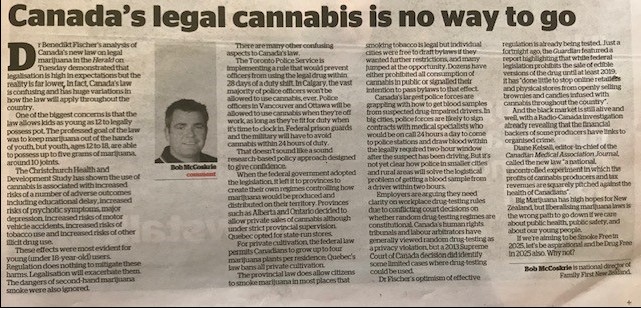Bob McCoskrie: Canada’s legal cannabis is no way to go
 Published in the NZ Herald, 29 November 2018
Published in the NZ Herald, 29 November 2018
Dr Benedikt Fischer’s analysis of Canada’s new law on legal marijuana demonstrates that cannabis legalisation is high in promise and expectations, but the reality is far lower.
In fact, Canada’s law is confusing and has huge variations of how the law will apply throughout the country.
One of the biggest concerns is that the law allows kids as young as 12 to legally possess pot. The professed goal of the law was to keep marijuana out of the hands of youth, but youth, ages 12 to 18, are able to possess up to five grams of marijuana – around 10 joints.
But the Christchurch Health and Development Study has shown from their research that the use of cannabis is associated with increased risks of a number of adverse outcomes including: educational delay; increased risks of psychotic symptoms; major depression; increased risks of motor vehicle accidents; increased risks of tobacco use; and increased risks of other illicit drug use. These effects were most evident for young (under 18-year-old) users.
Regulation does nothing to mitigate these harms. Legalisation will exacerbate them.
The dangers of second-hand marijuana smoke were also ignored.
There are many other confusing aspects to Canada’s law.
The Toronto Police Service is implementing a rule that would prevent officers from using the legal drug within 28 days of a duty shift. In Calgary, the vast majority of police officers won’t be allowed to use cannabis, ever. Police officers in Vancouver and Ottawa will be allowed to use cannabis when they’re off work, as long as they’re fit for duty when it’s time to clock in. Federal prison guards and the military will have to avoid cannabis within 24 hours of duty.
That doesn’t sound like a sound research-based policy approach designed to give confidence.
When the federal government adopted the legislation, it left it to provinces to create their own regimes controlling how marijuana would be produced and distributed on their territory. Provinces such as Alberta and Ontario decided to allow private sales of cannabis — although under strict provincial supervision. Quebec opted for state-run stores.
In terms of private cultivation, the federal law permits Canadians to grow up to four marijuana plants per residence; Quebec’s law bans all private cultivation.
The provincial law does allow citizens to smoke marijuana in most places that smoking tobacco is legal. But individual cities were free to draft bylaws if they wanted to add further restrictions, and many jumped at the opportunity. Quebec City, Sherbrooke, Levis, Saguenay, Magog, St-Jerome, Victoriaville and dozens of others have either prohibited all consumption of cannabis in public or signalled their intention to pass bylaws to that effect. Montreal, however, announced it would not add additional barriers to consuming cannabis.
Canada’s largest police forces are grappling with how to get blood samples from suspected drug-impaired drivers. In big cities, police forces are likely to sign contracts with medical specialists who would be on call 24 hours a day to come to police stations and draw blood within the legally required two-hour window after the suspect has been driving. But it’s not yet clear how police in smaller cities and rural areas will solve the logistical problem of getting a blood sample from a driver within two hours.
Employers are arguing they need clarity on workplace drug-testing rules due to conflicting court decisions on whether random drug-testing regimes are constitutional. Canada’s human rights tribunals and labour arbitrators have generally viewed random drug-testing as a privacy violation, but a 2013 Supreme Court of Canada decision did identify some limited cases where drug-testing could be used.
 Dr Fischer’s optimism of effective regulation is already being tested. Just a fortnight ago, The Guardian featured a report highlighting that while federal legislation prohibits the sale of edible versions of the drug until at least 2019, it has “done little to stop online retailers and physical stores from openly selling brownies and candies infused with cannabis throughout the country.”
Dr Fischer’s optimism of effective regulation is already being tested. Just a fortnight ago, The Guardian featured a report highlighting that while federal legislation prohibits the sale of edible versions of the drug until at least 2019, it has “done little to stop online retailers and physical stores from openly selling brownies and candies infused with cannabis throughout the country.”
And the black market is still alive and well, with a Radio-Canada investigation already revealing that the financial backers of some producers have links to organised crime.
Diane Kelsall, editor in chief of the Canadian Medical Association Journal, called the new law “a national, uncontrolled experiment in which the profits of cannabis producers and tax revenues are squarely pitched against the health of Canadians.”
Big Marijuana has high hopes for New Zealand, but liberalising marijuana laws is the wrong path to go down if we care about public health, public safety, and about our young people.
Drug use is a major health issue, and that’s why the role of the law is so important.
If we’re aiming to be Smoke Free in 2025, let’s be aspirational – and be Drug Free in 2025 also. Why not?






